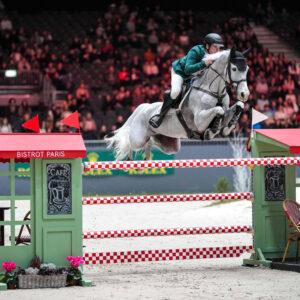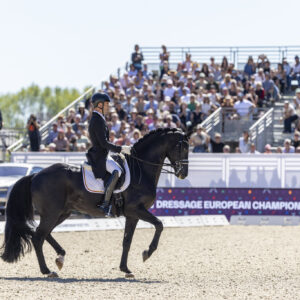If you’ve grown up in the world of horses like me, it’s likely you’ve wrestled with many a water trough!
Between the food droppings from the mouths of our livestock, mosquito larvae, and algae, keeping your horse’s water source clean is an ongoing challenge. Thankfully, there’s a hack for that y’all! Many people keep fish in their water troughs to help keep mosquito larvae and algae at bay, and they can work very well—IF you select the right fish for your trough and follow some tips and tricks to ensure you have happy horses AND happy fish.
LUCKY YOU, Horse Network asked yours truly, a nerdy horse-loving Aquatics Specialist, to help y’all out!
The most important decision: fish selection! We want to make sure the fish you select will be just as well-cared for as your horses, so we have a two great options.
Goldfish
The common goldfish is by far the most popular fish in existence. It is inexpensive and often kept in large aquariums and ponds, making it a common selection for the task of trough cleaning. Sadly, this is often (but not always) an unsuitable environment for them. Keep in mind through the article, a well-cared for goldfish will live 30 years or more, attain ten to 12 inches in length, and have a couple friends! So all the advice and #KnowledgeBombs are given to best achieve that goal.
Goldfish produce massive amounts of ammonia (five to 10 times that of the average same-sized fish). Unless you have a large volume of water, with several square feet of surface area for gas exchange (they need oxygen to breathe!) and plenty of plants and substrate (like pea gravel or lava rock) for good bacteria to grow on and break down fish waste, these likely won’t do well for you in the long run.
We recommend a trough that is 200 gallons or more and no more than one goldfish per 50 gallons. They also are a schooling fish, so make sure you have enough room to get three or more!
Being a cold-water fish, goldfish require water temps between 60–75 degrees Fahrenheit for most of the year, so make sure to check your water temps regularly. Many above ground water sources will get too warm, especially if they are not shaded! If you can’t move your trough, consider water lilies as a good option to naturally shade the water. They also break down some of the products of fish waste, helping keep a cleaner trough! Anacharis (aka Elodea) is a submersed aquatic plant that is also a great option for keeping water clean and it often will winter over.
When the water dips below 50 degrees your goldfish will begin to go dormant and settle at the bottom, waiting for spring to return and liven them up again. While goldfish are hardy and can winter over well in ponds with depths below the frost line, they may not do as well in a trough. We recommend you avoid leaving them in your trough if you’re in an area that experiences freezing temperatures unless you use a de-icer/heater. If your trough freezes solid, your goldfish will turn into the not so magical version of Elsa and that’s a bad day for everyone!
Onto feeding—any fish you buy and place in a trough will need to be fed (just not while dormant). Goldfish are vegetarians and in nature eat a wide variety of algae and plants. Algae and mosquito larva alone are not appropriate for 100% of their dietary needs. We recommend feeding goldfish pellets every other day to keep them happy and healthy! Pelleted foods will help keep water cleaner, because they don’t break up like flakes do. Also, the goldfish will learn to recognize you and swim up begging for food—making them a sweet little fishy just a lookin’ for their Krabby Patty! *swoons*
Isn’t amazing when you meet someone and there’s all this CHEMISTRY between you!? Well, fish are all about chemistry! (Water chemistry y’all, follow me here, they don’t want to fishy kiss you so calm down). Goldfish prefer a pH of 7.2-7.5 (basic/alkaline). So, make sure to test your water and check in with your local pet store if it’s off to find some ways to correct it. You should also have goal Ammonia and Nitrite levels of ZERO parts per million and Nitrates no higher than 10 parts per million. (Ammonia, Nitrite, and Nitrates are all products of fish waste and super fun to learn about, so if you’re a nerd check out the graphic at the bottom of this article!
Rosy Reds

©Wiki Commons
A great alternative to goldfish that will work well for smaller AND larger troughs are called “Rosy Reds.” Like goldfish, they are schooling fish. These bad boys only get an inch or two long, are grey or pink, live two to four years, and are cheap too! Let me hear ya holla to save a dolla!
Rosy Reds are much happier with the basic diet of algae and larvae in a trough due to their naturally similar dietary requirements, and they can tolerate warmer water temps than goldfish, while wintering over fairly well. They also produce much less waste than goldfish, so your horses potentially won’t be consuming such ammonia-laden water.
All that being said, please feed Rosy Reds their Krabby Patty Kibble! Feeding every other day will be fine.
We horse people are all about our supplements so let’s not skip out on our fishies! Rosy Reds can usually tolerate oxygen deficient environments a little better than goldfish and can tolerate a very wide range of pH (6.5-8.0 depending on what source you look at). They tolerate higher temps better too, but generally do best in water less than 85 degrees, so we still recommend lilies or other shade for your trough They should winter over with similar cold tolerances to goldfish, so just keep in mind your frost lines and freezing rates of your troughs so you don’t wind up with fishcicles!
Bonus tips for happy fish
*MOST Algae is healthy and helps keeps your water clean by breaking down nitrates and phosphates (by-products of fish waste and junk from your equine’s muzzle). It may not look pretty, but it’s healthy and it produces oxygen for your fish! Typically, it is brown or green and sticks to sides of your trough. Go ahead and dump the water if you need to but leave the algae so it can keep doin’ it’s cleanin’ thang.
*Put PVC pipes or clean rock or brick in the bottom of the trough to provide hidey holes for your fishes. They will love you for giving them a place to call home and hide from potential predators, like raccoons and herons!
*The three second memory is a myth! Goldfish and Rosy Reds have a great memory and can even remember who feeds them if you wear visual clues, like the same color shirt every time you feed.
*If possible, we recommend providing a filter for your fish. It will help your water stay cleaner and oxygenate it better. Check with your local pet stores for options.
*Goldfish surviving in bowls is a myth perpetuated by that rascal Elmo. If you pay attention he goes through several different Goldfish! Yes, some people MAY get a goldfish to live a few years in a large bowl, but it is not healthy for them. Their waste builds up and damages their organs, stunting their growth. Oxygen deprivation causes the same problems. Remember, they should get about one foot long and live 30 years easy, when properly cared for.


 July 9, 2018
July 9, 2018 




























